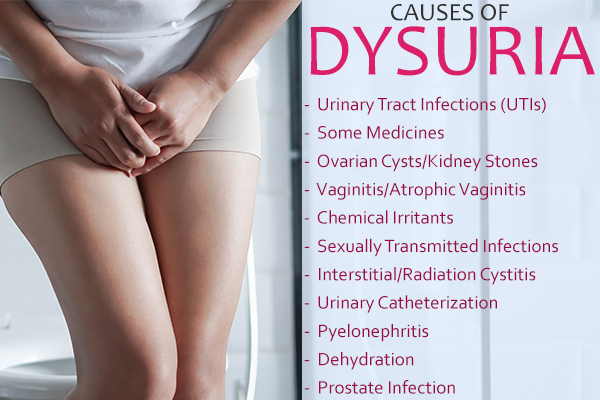In this article:
Dysuria is characterized by a feeling of pain in the urethra or urethral meatus (opening) while urinating and is generally accompanied by burning, itching, and stinging.

The pain and burning sensation originate from the pain receptors in the inflamed mucosal lining, which get stimulated on contact with urine. The stimulation causes contractions of the bladder muscles and urethra.
If the pain starts at the beginning of urination, it may be a urethra-related problem. If the pain occurs at the end of urination, it may indicate a bladder disorder.
How Common Is It?
Of all cases dealt by family physicians, 5%–15% are dysuria. This condition may be more common in women, but the incidence of dysuria in men increases with age. (1)
Men above 40 years of age are predisposed to UTIs due to the prevalence of prostatic hyperplasia, which obstructs the bladder outlet. Around 5% of men with urological problems are diagnosed with dysuria. (2)
Causes of Dysuria

Dysuria is often a symptom of other health problems rather than a disease in itself and may develop due to the following reasons:
- Urinary tract infections (UTIs): UTIs are the most likely cause of dysuria. These infections are more prevalent among women as their urethra is shorter and straighter in comparison with the long and curved urethra of men. Thus, bacteria can infect the bladder more quickly in females as less distance is to be covered.
- Medicines: Medications such as chemotherapy drugs may produce inflammation in the bladder.
- Ovarian cysts or kidney stones: Ovarian cysts may press against the bladder, while kidney stones can get stuck near the entrance of the bladder.
- Vaginitis: Infection or irritation in the vaginal area can also cause dysuria.
- Chemicals: The use of vaginal lubricants, contraceptive foams or sponges, soaps, scented toilet paper, douches, and related products that may contain chemical irritants can cause dysuria.
- Sexually transmitted infections: Chlamydia, gonorrhea, and herpes can cause painful urination.
- Interstitial cystitis: Also called painful bladder syndrome, interstitial cystitis is a chronic ailment characterized by pressure, burning, or pain in the bladder.
- Radiation cystitis: Radiation therapy of the pelvic area may damage the bladder lining.
- Urinary catheterization: The presence of a urinary catheter may allow entry of germs into the urinary tract, leading to an infection in the bladder or kidney, commonly known as catheter-associated urinary tract infection (CA-UTI). (3)
- Pyelonephritis: Bacterial infection in the kidney can cause inflammation and pain during urination.
- Atrophic vaginitis: Tissue changes in the vagina occurring post-menopause may cause dysuria.
- Dehydration: Lack of fluid intake or low water body levels may cause discomfort while urinating.
- Prostate infection: Bacterial infection in the prostate gland can cause swelling and painful urination.
Symptoms of Dysuria

Dysuria generally refers to a sensation of pain while urinating. It may also be accompanied by the following symptoms:
- Burning or stinging while peeing
- Increased frequency of urination
- Malodor in the urine
- Bloody or discolored urine
- Fever
- Loss of appetite
- Lethargy
- Irritability
- Vomiting and nausea
- Lower back pain
- Abdominal pain
- Wetting incidents (in potty-trained toddlers)
Treatment for Dysuria
The treatment for dysuria is dependent on the underlying reason:
1. Cystitis and pyelonephritis
These bacterial infections can be treated with oral antibacterial drugs. For severe pyelonephritis accompanied by shivering, chills, high fever, and vomiting, the antibiotics may be administered intravenously.
2. Urethritis
This may result from various infections, which are treated with different antibiotics.
3. Vaginitis
If caused by a yeast infection, vaginitis is treated with antifungal drugs, which are available as oral pills, creams, or suppositories inserted in the vagina. For bacterial vaginosis and trichomoniasis, antibiotics are prescribed.
Dysuria caused by a sexually transmitted infection (STI) will only subside when both sexual partners get treated for the STI.
Diagnosing the Cause of Dysuria
Finding the root cause of dysuria involves a series of diagnostic steps, which begins with a review of the patient’s medical history and symptoms.

The followed tests are then performed:
1. Urinalysis
A urine sample is collected to check its color and clarity; determine the presence of substances such as sugar, protein, and bilirubin; and detect any blood, crystals, or infection.
2. Ultrasound
The bladder and kidneys are imaged and scanned to check for inflammation or other pathologies.
3. Cystoscopy
The inside of the bladder is visualized using a lighted telescope.
4. Discharge culture
A pelvic exam may be performed on women having vaginal discharge. The vaginal fluids are collected and sent to the laboratory for culturing. For men having discharge from the penis, a urethral swab test is done. These tests are performed in a few cases only.
Risk Factors for Dysuria
The following factors may predispose you to dysuria:
- Ages between 24 and 54
- Physical activities such as cycling or horse riding
- Unprotected sexual intercourse
Complications Associated With Dysuria
Dysuria may lead to various short-term and long-term complications depending on its cause. The short-term complications that can occur due to dysuria include:
- Acute renal failure
- Acute anemia from hematuria
- Emergent hospitalization
Dysuria can also lead to the following chronic problems:
- End-stage renal disease
- Infertility
- Urinary tract cancers
- Disability from recurrent infections
- Fatal systemic infection and sepsis
In some cases, UTIs may be recurrent and call for repetitive treatments, which can lead to antibiotic resistance, increasing the chances of hospitalization, morbidity, and mortality.
When to See a Doctor

Seek medical help if you experience severe pain while urination, especially if it is accompanied by:
- Fever
- Back pain
- Abdominal pain
- Abnormal urethral or vaginal discharge
- Blood in the urine
- Increased urinary frequency and a pressing need to pee
Expert Answers (Q&A)
Answered by Dr. Daniel C. Edwards, DO (Urologist)
Dysuria can be due to issues originating in the bladder or urethra. The causes can be neurological, inflammatory, obstructive, or even cancerous.
The most common cause of dysuria in females is a urinary tract infection, whereas the most common cause in males is obstruction by an enlarged prostate.
Dysuria may also be caused by a bladder that squeezes too hard or too frequently, non-infectious inflammatory conditions, sexually transmitted diseases, stones in the bladder, scar tissue in the urethra, or, in some cases, cancer.
Dysuria is a symptom, not a diagnosis or disease. Dysuria may be a symptom of an STD and, therefore, must be evaluated by a physician.
The duration of dysuria is dependent upon the cause. It could be transient or a chronic issue.
The most important thing to understand is that the most common causes of dysuria are benign and can be addressed by a primary care physician and/or urologist.
However, it is imperative that patients with dysuria be evaluated by a medical professional to rule out potentially devastating conditions, such as bladder cancer.
About Dr. Daniel C. Edwards, DO: Dr. Edwards is a urologist and practices in Southeastern Pennsylvania. He has a special interest in cancerous conditions that affect the kidneys, bladder, prostate, and genitalia.
Final Word
Pain or burning during urination is known as dysuria and may cause continuous urethral discomfort. The treatment depends on the reason behind the problem.
In rare cases, the cause can be a tumor. If a cancerous mass in the urinary tract is suspected in the primary diagnosis, a referral to a urologist (urinary tract specialist) is highly recommended.
Further tests can help determine if the tumor is malignant, so proper treatment can be given. In the case of cancer, the treatment depends on its type and severity but generally includes surgery, chemotherapy, radiotherapy, or immune therapy.

- Was this article helpful?
- YES, THANKS!NOT REALLY


